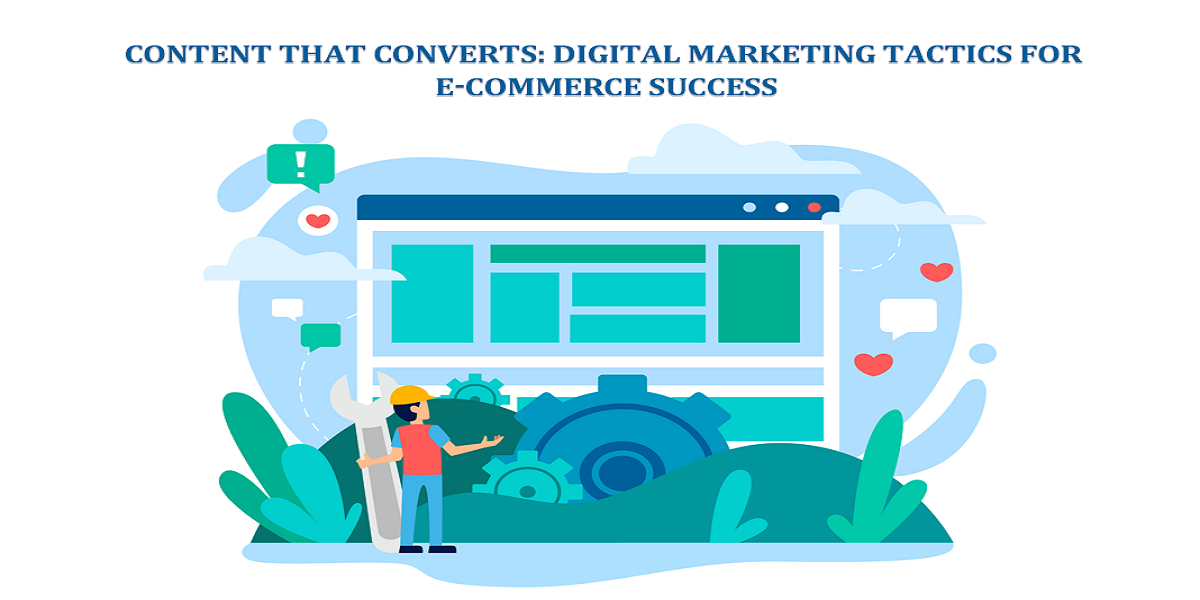
Content that Converts: Digital Marketing Tactics for E-Commerce Success
- By Motif Creatives
- 02-05-2024
- E-commerce
Did you know the global e-commerce market is expected to reach over 47 trillion US dollars by 2030? In today's digital world, e-commerce reigns supreme, but with so much competition, simply having an online store isn't enough.
The challenge for e-commerce businesses lies in converting those website visitors into paying customers. Many visitors browse, fill their carts, and then mysteriously disappear before completing the purchase.
This is where the power of "content that converts" comes in. This article dives deep into the world of content marketing for e-commerce success. We'll explore how to build a winning content strategy, leverage other digital marketing tactics like SEO and social media, and optimize your website for conversions. Get ready to turn website visitors into loyal customers!
The Power of Content Marketing for E-Commerce
In the ever-crowded world of online shopping, there's too much competition. This is where content marketing intervenes. It's strategically creating and distributing valuable, relevant, and consistent content to attract and keep a clearly defined audience—and to drive profitable customer action.
How Content Marketing Attracts, Engages, and Converts
Valuable content acts as a magnet, drawing in potential customers searching for information about your products or industry.
Informative and engaging content keeps visitors on your site longer, fosters brand awareness and establishes you as a thought leader.
Well-crafted content educates potential customers about your products, builds trust in your brand, and gently nudges them toward purchasing.
Benefits of Content Marketing for E-Commerce
- Increased brand awareness
- Improved search engine optimization (SEO)
- Building trust and credibility
- Educating and nurturing leads
- Driving targeted traffic
- Boosting conversions and sales
Types of Content for E-Commerce Success
The beauty of content marketing is its versatility. Here are some popular content formats for e-commerce businesses:
- Blog Posts: Informative blog posts can cover buying guides, product reviews, industry trends, and more.
- Infographics and Visual Content: Eye-catching infographics and visuals can present complex information clearly and engagingly.
- Videos: Product demos, tutorials, and explainer videos can showcase your products in action and answer customer questions.
- Social Media Content: Engaging social media posts, stories, and live streams can connect with your audience and promote your products.
- Email Marketing: Informative newsletters, abandoned cart recovery emails, and promotional offers can nurture leads and drive sales.
Building a Content Marketing Strategy
The foundation of any successful content marketing campaign is a solid strategy. Here's what you need to consider:
Know Your Audience
Before creating content, you need to understand who you're making it for. This is where buyer personas are essential. These are detailed profiles of your ideal customers, outlining their demographics, needs, interests, and pain points. By understanding your audience, you can tailor your content to resonate with them and address their concerns.
Content Planning and Calendar
With buyer personas in mind, develop a content calendar that aligns with your audience's needs and business goals. Plan your content mix, including blog posts, videos, infographics, etc., ensuring consistency and a steady flow of fresh content.
SEO Best Practices
Don't forget about search engines! Utilize keyword research to identify relevant keywords your target audience uses to search for products or information related to your industry. Integrate these keywords naturally throughout your content, but prioritize user experience over keyword stuffing.
Creating Compelling Content
Now comes the fun part—creating content that engages and converts! Consider these necessary points:
- Focus on Value: Your content should be valuable to your audience. Provide solutions to their problems, answer their questions, and educate them about your products in a helpful, informative way.
- User Intent: Understand what your audience looks for when they visit your site. Are they researching a product? Looking for buying advice? Tailor your content to their specific intent.
- Storytelling: People connect with stories. Add narratives to your content to engage your audience emotionally.
- Engaging Writing Style: Use clear, concise, and engaging language. Break up text with visuals and consider different writing styles like listicles or "how-to" guides to keep your audience interested.
- High-Quality Visuals: Humans are visual creatures. Complement your text with high-quality images, infographics, and WooCommerce Product Videos to enhance understanding and brand recognition.
- Calls to Action (CTAs): Don't leave your audience hanging! Tell them what you want them to do next, whether visiting a product page, signing up for your email list, or purchasing.
Content Distribution and Promotion
Creating great content is only half the battle. You also need a strategy to get it to your target audience. Some effective methods include social media, paid advertising, and influencer marketing.
To use relevant social media platforms to organically reach your audience, you need to share your content, engage in conversations, and build a community around your brand.
Paid advertising strategies on social media platforms or search engines allow you to target your ideal customers and reach a wider audience. Also, collaborate with relevant influencers in your industry to promote your content and tap into their established audience.
Beyond Content: Additional Digital Marketing Tactics
Content marketing is a powerful tool that doesn't operate in isolation. To truly thrive in the e-commerce landscape, you need a comprehensive digital marketing strategy that leverages various tactics in concert. Here's a look at some key elements to consider alongside your content creation efforts:
Search Engine Optimization (SEO)
Think of SEO as the magic ingredient that helps your website rank higher in search engine results pages (SERPs). By optimizing your website and content for relevant keywords, you increase the chances of potential customers finding you organically when they search for products or information related to your industry. Some crucial SEO practices include on-page optimization, backlink building, and mobile responsiveness and speed.
On-page optimization involves optimizing product pages and website content with relevant keywords. Integrate these keywords throughout your product descriptions, titles, meta tags, and website copy. However, prioritize the user experience, as keyword stuffing can backfire and hurt your ranking.
Backlinks are links from other websites pointing back in your direction. Earning backlinks from high-authority websites in your niche signals credibility to search engines and can significantly boost your ranking.
In today's mobile-first world, ensuring your website is optimized for mobile devices and loads quickly is crucial. Not only does this improve the user experience, but search engines also prioritize mobile-friendly websites.
Pay-Per-Click (PPC) Advertising
While SEO focuses on organic reach, PPC advertising allows you to target your ideal customers directly through paid ads on search engines like Google or social media platforms. You can leverage PPC effectively by choosing the right platform, creating targeted campaigns, and retargeting.
To choose the right platform, you need to identify platforms where your target audience spends their time. Then, you can use PPC with popular options like Google Ads, Facebook Ads, and Instagram Ads.
Creating targeted campaigns using relevant keywords and ad copy that resonate with your ideal customer is essential. Retargeting is crucial as well. You need to retarget website visitors who have shown interest in your products but haven't converted yet. Retargeting campaigns can be a powerful tool to bring them back to your site and nudge them toward purchasing.
Social Media Marketing
Social media platforms offer a fantastic way to connect with your audience on a more personal level, build brand awareness, and ultimately drive sales. Digital marketers can integrate social media into their e-commerce strategy by choosing the right platforms, creating a solid presence, building community, and using social media analytics.
Choosing the right platform is necessary to allow you to target your audience precisely. Build a solid social media presence once you've identified the right platforms. Regularly share engaging content, run contests and promotions, and promptly respond to comments and messages.
Social media is all about fostering interaction. Encourage conversations, answer questions, and build a community around your brand. This promotes loyalty and trust, encouraging customers to choose you over competitors.
Additionally, utilize social media analytics tools to track the performance of your campaigns, understand what resonates with your audience, and continuously refine your strategy.
Email Marketing
Email marketing remains a powerful tool for nurturing leads, driving sales, and fostering customer loyalty. You can leverage email marketing effectively by building an email list, segmenting your audience, personalizing content, nurturing leads, and recovering abandoned carts.
You can grow your email list organically through website opt-in forms and promotions. Remember, focus on permission-based marketing; never buy email lists. However, don't blast generic emails to your entire list. Segment your audience on the basis of demographics, interests, and purchase history. This allows you to send targeted email campaigns that resonate more effectively.
Personalization matters a lot. Use email automation tools to personalize your email content with greetings by name, relevant product recommendations, and targeted offers. You should use email marketing to nurture leads throughout the buying journey. This allows you to provide educational content, address customer pain points, and offer incentives to move them closer to the conversion stage.
Keep abandoned carts from becoming lost sales opportunities. Utilize email automation to send targeted emails reminding customers about products left in their carts and offering incentives to complete their purchases.
Combining these four tactics with your content marketing efforts creates a well-rounded digital marketing strategy that attracts potential customers, builds brand loyalty, and drives sales for your e-commerce business.
Optimizing for Conversions
So, you've attracted potential customers with valuable content and engaged them with targeted digital marketing campaigns. It's time to ensure a smooth and frictionless experience that converts those visitors into paying customers. Here's where website optimization comes in:
Website User Experience (UX)
Just like a cluttered store with confusing layouts can deter customers, a poorly designed website can frustrate visitors and send them running to the competition. Here are some key UX elements to prioritize:
- Clear Navigation: Your website navigation should be intuitive and user-friendly. Visitors should be able to quickly find the products they're looking for with minimal clicks. Utilize clear categories, subcategories, and a well-placed search bar.
- Product Pages: Product pages are your salesforce. Make sure they’re visually appealing and informative. Include high-quality product images from different angles, detailed descriptions highlighting features and benefits, and clear calls to action (CTAs) encouraging users to add products to their cart.
- Checkout Process: A lengthy or confusing checkout process is a conversion killer. Streamline your checkout process, minimizing the steps required to complete a purchase. Offer guest checkout options and ensure secure payment gateways to build trust with customers.
- Website Speed and Mobile-Friendliness: In today's fast-paced world, website speed is crucial. Nobody wants to wait for a slow-loading website. Optimize your website for speed and ensure it's fully responsive and mobile-friendly. A significant portion of online shopping now happens on mobile devices, so a seamless mobile experience is essential.
A/B Testing
The best way to optimize your website for conversions is through continuous testing and refinement. Utilize A/B testing tools to compare different versions of website elements, such as product page layouts, calls to action, or checkout processes. You can continuously improve your website's conversion rate by analyzing data and identifying which variations perform better.
Product Descriptions and Reviews
High-quality product descriptions are essential for educating potential customers and boosting conversions. Here's what to focus on:
- Compelling and Informative: Go beyond simply listing features. Craft persuasive product descriptions highlighting your products' benefits and how they solve customer problems. Use clear and concise language, focusing on the value proposition for your target audience.
- Encouraging Customer Reviews and Testimonials: Positive customer reviews and testimonials are influential trust builders. Motivate customers to leave reviews and display them prominently on your product pages. Genuine customer feedback builds trust and credibility, influencing purchase decisions.
By prioritizing website optimization and focusing on these elements, you create a user-friendly experience that guides visitors toward conversion and ultimately fuels your e-commerce success.
Conclusion
By creating valuable, informative, and engaging content, you establish yourself as a thought leader in your industry, educate your audience about your products, and gently nudge them toward conversion. However, content marketing is just one piece of the puzzle. For ultimate success, you need a comprehensive digital marketing strategy that leverages SEO, social media marketing, email marketing, and website optimization.
By implementing these strategies effectively, you can transform your e-commerce business from surviving to thriving in the competitive online marketplace. Remember, it's about more than just selling products—building relationships with your customers and fostering brand loyalty that will keep them returning for more.
Recent blog

Conquering the Explore Page: Fine-tuning Your Instagram Social Media Strategy
Social Media | 16-05-2024
10 Key Elements of a Powerful Sales Tech Stack
Technology | 15-05-2024




